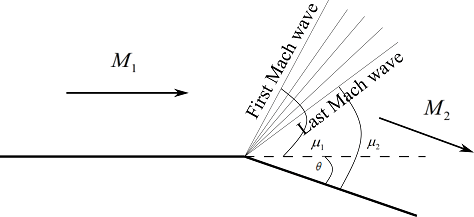What are expansion waves?
What are expansion waves? How does it originates?
Expansion waves are formed when there is a supersonic flow over a curved surface or a convex corner. Expansion waves on a convex corner are in the shape of a fan with its center at the corner.
 Expansion wave formed over a curved surface
Expansion wave formed over a curved surface
Flow passing the expansion waves are deflected by deflection angle, \(\theta\), and streamlines of the flow are parallel to each other. The expansion fan has an infinite number of Mach waves which diverges from the sharp corner. These Mach waves make an angle, \(\mu \), with the local flow direction. The first Mach wave is at an angle of \({\mu _1} = {\sin ^{ – 1}}\left( {\frac{1}{{{M_1}}}} \right).\) with respect to the flow direction. The last Mach wave is at an angle of \({\mu _2} = {\sin ^{ – 1}}\left( {\frac{1}{{{M_2}}}} \right).\)
 Expansion fan formed over a convex corner
Expansion fan formed over a convex corner
Across an expansion wave pressure, temperature and density decreases where as Mach number increases. The deflection angle, \(\theta\), of the flow can be calculated from Prandtl-Meyer function, \[\theta = \nu \left( {{M_2}} \right) – \nu \left( {{M_1}} \right)\]
where,
\[\nu \left( M \right) = \sqrt {\frac{{\gamma + 1}}{{\gamma – 1}}} {\tan ^{ – 1}}\sqrt {\frac{{\gamma – 1}}{{\gamma + 1}}\left( {{M^2} – 1} \right)} – {\tan ^{ – 1}}\sqrt {{M^2} – 1} \]




